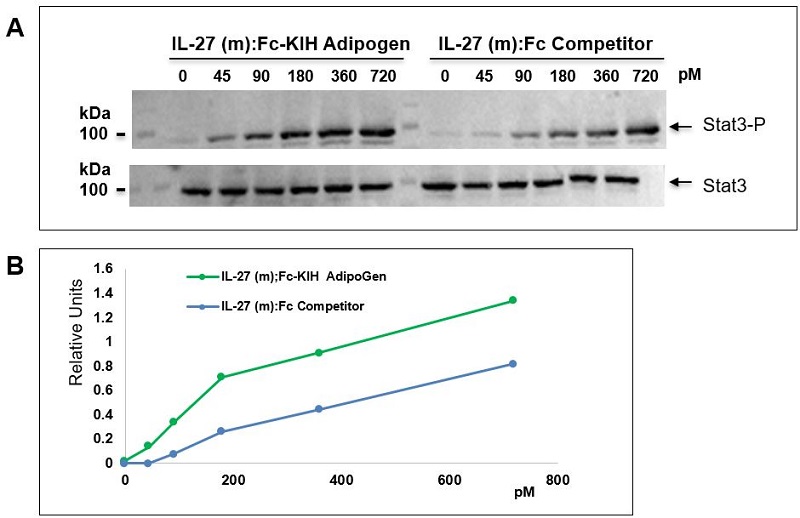IL-27 (mouse):Fc-KIH (human) (rec.)
| Code | Size | Price |
|---|
| AG-40B-0236-C050 | 50 ug | £360.00 |
Quantity:
Prices exclude any Taxes / VAT
Overview
Host Type: CHO Cells
Regulatory Status: RUO
Target Species:
- Human
- Mouse
Shipping:
BLUE ICE
Storage:
Short term storage:+4°C. Long term storage:-20°C.
Images
Documents
Further Information
Alternate Names/Synonyms:
IL-27 (mouse):Fc Knobs-into-Holes (human) (rec.); Interleukin-27 Subunit alpha; IL-27 Subunit alpha; IL-27-A; Interleukin-27 Subunit beta; Ebi3; Epstein-Barr Virus-induced Gene 3 Protein Homolog
Biological Activity:
Activates STAT3 phosphorylation in mouse and human cells.
Concentration:
1mg/ml after reconstitution.
EClass:
32160000
Endotoxin:
<0.01EU/ug purified protein (LAL test).
Form (Short):
solid
Formulation:
Lyophilized. Contains PBS
Handling Advice:
After reconstitution, prepare aliquots and store at -20°C. Avoid freeze/thaw cycles. Centrifuge lyophilized vial before opening and reconstitution. PBS containing at least 0. 1% BSA should be used for further dilutions.
Long Description:
Recombinant protein. IL-27A/p28 (aa 29-234) (mouse):Fc Knobs and IL-27B/EBI3 (aa 19-228) (mouse):Fc Holes form the IL-27 (mouse):Fc-KIH (human) using the Knobs-into-Holes technology (see reference: J.B. Ridgway, et al.; Protein Eng. 9, 617 (1996)). Activates STAT3 phosphorylation in mouse and human cells. Source: CHO cells. Lyophilized. Contains PBS Interleukin-12 (IL-12) family members are heterodimer glycoproteins, composed of two covalently linked subunits, alpha and beta chains. The alpha-subunit consists of IL-23p19, IL-27p28, and IL-12p35, and the beta-subunit includes IL-12p40 and Epstein-Barr virus-induced gene (Ebi3). IL-12 members bind to cognate heterodimeric receptor chains expressed on T cells. This family includes IL-12, IL-23, IL-27 and IL-35 and IL-39. IL-12 and IL-23 are predominantly proinflammatory cytokines that contribute key roles in the development of Th1 and Th17 cells, respectively. IL-27 has both pro- and anti-inflammatory properties and is a potent T cell immunomodulator. IL-35, a new member of this family, is a potent inhibitory cytokine produced by natural, thymus-derived regulatory T cell (nTreg) populations. IL-39, the newest member of IL-12 family, mediates the inflammatory response through the activation of STAT1/STAT3 signaling pathway. These IL-12 family members link innate immunity with the development of adaptive immunity and are also important for regulating T cell responses. IL-27 is composed of two subunits, IL-27p28 and Epstein-Barr virus-induced gene 3 (EBI3) signals via a heterodimeric receptor consisting of WSX-1 and glycoprotein (gp130), leading to activation of STAT 1 and 3. IL-27 is pro-inflammatory and promotes NK and T cell proliferation as well as the production of IFN-gamma. It is anti-inflammatory, inhibiting Th2 and Th17 cell activities and stimulating the production of IL-10 by T regulatory cells. IL-27 has potent antiviral activities against numerous viruses, by increasing the production of interferons (IFNs). Finally, IL-27 has antitumor activity as well as anti-angiogenic activity with activation of the production of anti-angiogenic chemokines. The protein IL-27 (mouse):Fc-KIH (human) (rec.) is produced by using two different vectors, one encoding for the IL-27A/p28:Fc Knobs sequence (synthesizing a protein of 62kDa) and one encoding for the IL27B/EBI3: Fc Holes sequence (synthesizing a protein of 60kDa). Both vectors transfected into CHO cells produce both Fc molecules (Knobs-into-Holes technology; J.B. Ridgway, et al.; Protein Eng. 9, 617 (1996)) required for dimerization and for secretion of the final protein IL-27 (mouse): Fc-KIH (human) (rec.).
Molecular Weight:
~62kDa and 60 kDa (SDS-PAGE)
NCBI, Uniprot Number:
Q8K3I6/O35228
Package Type:
Plastic Vial
Product Description:
Interleukin-12 (IL-12) family members are heterodimer glycoproteins, composed of two covalently linked subunits, alpha and beta chains. The alpha-subunit consists of IL-23p19, IL-27p28, and IL-12p35, and the beta-subunit includes IL-12p40 and Epstein-Barr virus-induced gene (Ebi3). IL-12 members bind to cognate heterodimeric receptor chains expressed on T cells. This family includes IL-12, IL-23, IL-27 and IL-35 and IL-39. IL-12 and IL-23 are predominantly proinflammatory cytokines that contribute key roles in the development of Th1 and Th17 cells, respectively. IL-27 has both pro- and anti-inflammatory properties and is a potent T cell immunomodulator. IL-35, a new member of this family, is a potent inhibitory cytokine produced by natural, thymus-derived regulatory T cell (nTreg) populations. IL-39, the newest member of IL-12 family, mediates the inflammatory response through the activation of STAT1/STAT3 signaling pathway. These IL-12 family members link innate immunity with the development of adaptive immunity and are also important for regulating T cell responses. IL-27 is composed of two subunits, IL-27p28 and Epstein-Barr virus-induced gene 3 (EBI3) signals via a heterodimeric receptor consisting of WSX-1 and glycoprotein (gp130), leading to activation of STAT 1 and 3. IL-27 is pro-inflammatory and promotes NK and T cell proliferation as well as the production of IFN-gamma. It is anti-inflammatory, inhibiting Th2 and Th17 cell activities and stimulating the production of IL-10 by T regulatory cells. IL-27 has potent antiviral activities against numerous viruses, by increasing the production of interferons (IFNs). Finally, IL-27 has antitumor activity as well as anti-angiogenic activity with activation of the production of anti-angiogenic chemokines. The protein IL-27 (mouse):Fc-KIH (human) (rec.) is produced by using two different vectors, one encoding for the IL-27A/p28:Fc Knobs sequence (synthesizing a protein of 62kDa) and one encoding for the IL27B/EBI3: Fc Holes sequence (synthesizing a protein of 60kDa). Both vectors transfected into CHO cells produce both Fc molecules (Knobs-into-Holes technology; J.B. Ridgway, et al.; Protein Eng. 9, 617 (1996)) required for dimerization and for secretion of the final protein IL-27 (mouse): Fc-KIH (human) (rec.).
Purity:
>95% (SDS-PAGE)
Sequence:
IL-27A/p28 (aa 29-234) (mouse):Fc Knobs and IL-27B/EBI3 (aa 19-228) (mouse):Fc Holes form the IL-27 (mouse):Fc-KIH (human) using the Knobs-into-Holes technology (see reference: J.B. Ridgway, et al.; Protein Eng. 9, 617 (1996)).
Source / Host:
CHO cells
Specificity:
Binds to the mouse and human Il-27 receptor complex.
TAGs:
Fc
Transportation:
Non-hazardous
UNSPSC Number:
41116127
Use & Stability:
Stable for at least 6 months after receipt when stored at -20°C.Working aliquots are stable for up to 3 months when stored at -20°C.



